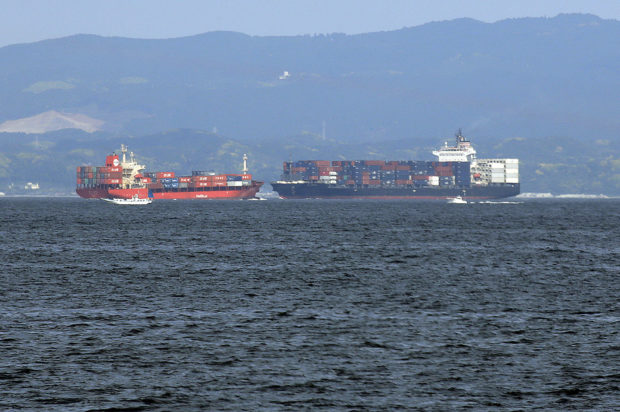US warship clash site known for congested nighttime traffic

In this June 17, 2017, photo, the damaged Philippine-registered container ship ACX Crystal, right, cruises past another container ship off Yokosuka, south of Tokyo, after colliding with the USS Fitzgerald off Japan earlier in the day, which resulted in the death of seven U.S. sailors. The site of a fatal collision between the two vessels off Japan’s coast is notorious for congested sea traffic, particularly during the night when merchant ships are trying to reach Tokyo’s port by daybreak. (AP Photo/Eugene Hoshiko)
TOKYO—The site of a fatal collision between a U.S. Navy destroyer and a container ship off Japan’s coast is notorious for congested sea traffic, particularly during the night when merchant ships are trying to reach Tokyo’s port by daybreak.
READ: 7 missing, 2 hurt after US Navy destroyer collides with PH-flagged ship
The USS Fitzgerald and the Philippine-registered ACX Crystal collided about 12 nautical miles (14 miles, 22 kilometers) off the southern tip of the Izu Peninsula in the early hours of Saturday just as the two ships were to merge into heavy traffic.
Maritime officials and ship operators call the area a convergence zone, where ships coming from the east and west converge with others leaving Tokyo. On average, about 400 ships pass through the waters each day.
The area, also known for strong tides, is the most accident-prone in Japanese waters. The Japan Transport Safety Board investigated 28 serious collisions between 2008 and 2014, including one between a Japanese navy submarine and a fishing boat in 1988 in which 30 people died.
Article continues after this advertisement“Because many ships unload their cargo in Tokyo during the day, they want to be there early in the morning. Many of them pass through the area during the night,” said Hiroshi Ando, an official in the Japanese coast guard’s navigation safety department. “It’s known as one of the busiest waters, where ships from different routes merge.”
Article continues after this advertisementThe nighttime rush lasts from about 1 a.m. to 3 a.m. A second rush hour goes from about 8 p.m. to 9 p.m. as ships that reloaded in Tokyo leave through the area, he said.
The ACX Crystal was a typical example. The 19,060-ton ship, carrying about 1,000 containers from Nagoya, was eastbound scheduled to arrive in Tokyo at 8 a.m., according to its operator, NYK Line. The coast guard says the container ship and destroyer collided about 1:30 a.m.
How the collision occurred is still under investigation, but experts generally agree the Philippine-flagged container ship was likely trying to pass the destroyer from behind when the two collided. The Navy ship had severe damage to its starboard side. An underwater gash flooded two sleeping compartments, killing seven trapped sailors.
Ships heading to Tokyo have to decide whether to take a shortcut between the Izu Peninsula and Izu Oshima island, or make a bigger circle around the island, partly to avoid traffic. Most ships take the shorter route, Ando said. He said route decisions are up to the captains.
Because of the frequent accidents, the transport ministry has proposed to the International Maritime Organization a virtual median line between the peninsula and the island, with Tokyo-bound ships traveling on the east side and those from Tokyo on the west side. The proposal, adopted by the IOM earlier this month, is to take effect next year.
A senior official at Shinshinkisen Co., a passenger ferry operator, said it assigns three crewmembers to monitor surrounding traffic when its ferries pass through the area, even though they only operate during the day. He spoke on condition of anonymity because of the sensitivity of the topic.
But after following all the rules and carefully monitoring other vessels, ships that make it through the congested area then reach Tokyo Bay, which is even more crowded, he said. JPV/rga